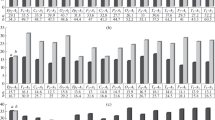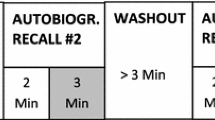Abstract
The EEG spatial synchronization in the frequency bands Δ, θ, α1, α2, β1, and β2 was studied on the basis of estimations of corresponding mean values of the coherence function in two groups of subjects (students actors and nonactors) during internal induction of emotional states by means of recall of autobiographic experience and mental performance of given scenic situations as a known character. Emotion-induced changes in the state of the cortex were reflected in statistically significant heterogeneous changes in the EEG spatial synchronization in many cortical areas and different frequency bands. The results obtained are discussed in combination with data presented earlier on changes in EEG local synchronization obtained in the course of the same experiments. The EEG β bands stand out against the background of extensive changes in the local and spatial EEG synchronization: the EEG changes in these bands are most prominent. Also, the changes in the prefrontal and temporal cortical areas, most involved in actualization of emotional states, are noteworthy. Some of the findings can be interpreted as confirming the hypothesis about neurophysiological mechanisms of brain defense from functionally excessive emotions.
Similar content being viewed by others
REFERENCES
Danko, S.G., Bechtereva, N.P., Shemyakina, N.V., and Antonova, L.V., Electroencephalographic Correlates of Mental Performance of Emotional Personal and Scenic Situations. I. Characteristics of Local Synchronization, Fiziol. Chel., 2003, vol. 29, no. 3, p. 5.
Sviderskaya, N.E., Sinkhronnaya elektricheskaya aktivnost' mozga i psikhicheskie protsessy (Synchronous Electric Brain Activity and Mental Processes), Moscow: Nauka, 1987.
Petsche, H., Approaches to Verbal, Visual, and Musical Creativity by EEG Coherence Analysis, Int. J. Psychophysiol., 1996, vol. 24, no. 2, p. 145.
Ivanitsky, A.M., Synthesis of Information in the Key Cortical Regions as the Basis of Subjective Feeling, Zh. Vyssh. Nerv. Deyat. im. I.P. Pavlova, 1997, vol. 47, no. 2, p. 209.
Rusalova, M.N., Reflection of Emotional Tension in the Spatial Synchronization of Biopotentials of the Human Brain, Zh. Vyssh. Nerv. Deyat. im. I.P. Pavlova, 1990, vol. 40, no. 2, p. 254.
Tucker, D.M. and Dawson, S.L., Asymmetric EEG Changes as Method Actors Generated Emotions, Biol. Psychol., 1984, vol. 19, no. 1, p. 63.
Kostyunina, M.B., Crosscorrelation Coefficients of Cortical Biopotentials and Autonomic Characteristics during Mental Reproduction of Emotional States in Humans, Zh. Vyssh. Nerv. Deyat. im. I.P. Pavlova, 1996, vol. 46, no. 3, p. 600.
Aftanas, L.I., Emotsional'noe prostranstvo cheloveka: psikhofiziologicheskii analiz (Human Emotional Space: Psychophysiological Analysis), Novosibirsk: Sibirskoe Otdelenie Ross. Akad. Med. Nauk, 2000.
Gray, J.R., Braver, T.S., and Raichle, M.E., Integration of Emotion and Cognition in the Lateral Prefrontal Cortex, Proc. Natl. Acad. Sci. USA, 2002, vol. 99, no. 6, p. 4115.
Perlstein, W.M., Elbert, T., and Stenger, V.F., Dissociation in Human Prefrontal Cortex of Affective Influences on Working Memory-related Activity, Proc. Natl. Acad. Sci. USA, 2002, vol. 99, no. 3, p. 1736.
Keightley, M.L., Winocur, G., Graham, S.J., et al., An fMRI Study Investigating Cognitive Modulation of Brain Regions Associated with Emotional Processing of Visual Stimuli, Neuropsycologia, 2003, vol. 41, no. 5, p. 585.
Tulving, E., Episodic Memory: From Mind to Brain, Ann. Rev. Psychol., 2002, vol. 53, no. 1, p. 1
Cole, H.W. and Ray, W.J., EEG Correlates of Emotional Tasks Related to Attentional Demands, Int. J. Psychophysiol., 1985, vol. 3, p. 33.
Rusalova, M.N., The Role of Emotions in the Control of Wakefulness Level, Doctoral (Med.) Dissertation, Moscow: Inst. of Higher Nerv. Activity and Neurophysiol., USSR Acad. Sci., 1983.
Crawford, H.J., Clarke, S.W., and Kitner-Triolo, M., Self-generated Happy and Sad Emotions in Low and Highly Hypnotizable Persons during Waking and Hypnosis: Laterality and Regional EEG Activity Differences, Int. J. Psychophysiol., 1996, vol. 24, no. 3, p. 239.
Klimesch, W., EEG Alpha and Theta Oscillations Reflect Cognitive and Memory Performance: A Review and Analysis, Brain Res. Rev., 1999, vol. 29, nos. 2–3, p. 169.
Klimesch, W., Doppelmayr, M., Schwaiger, J., et al., “Paradoxical” Alpha Synchronization in a Memory Task, Brain Res. Cogn. Brain Res., 1999, vol. 7, no. 4, p. 493.
Gabrieli, J.D., Functional Neuroimaging of Episodic Memory, Handbook of Functional Neuroimaging of Cognition, Cabeza, R. and Kingstone, A., Eds., Cambridge: MIT Press, 2001, p. 253.
Bechtereva, N.P., Bioelectric Correlates of Brain Defense Mechanisms, Zh. Nevropatol. Psikhiatr. im. S.S. Korsakova, 1980, vol. 30, no. 8, p. 1127.
Bechtereva, N.P., Zdorovyi i bol'noi mozg cheloveka. Btoroe izdanie, pererabotannoe i dopolnennoe (Healthy and Ill Human Brain. The Second Edition, Revised and Supplemented), Leningrad: Nauka, 1988.
Author information
Authors and Affiliations
Rights and permissions
About this article
Cite this article
Danko, S.G., Bechtereva, N.P., Shemyakina, N.V. et al. Electroencephalographic Correlates of Mental Performance of Emotional Autobiographic and Scenic Situations: II. Characteristics of Spatial Synchronization. Human Physiology 29, 685–693 (2003). https://doi.org/10.1023/B:HUMP.0000008839.44532.62
Issue Date:
DOI: https://doi.org/10.1023/B:HUMP.0000008839.44532.62




